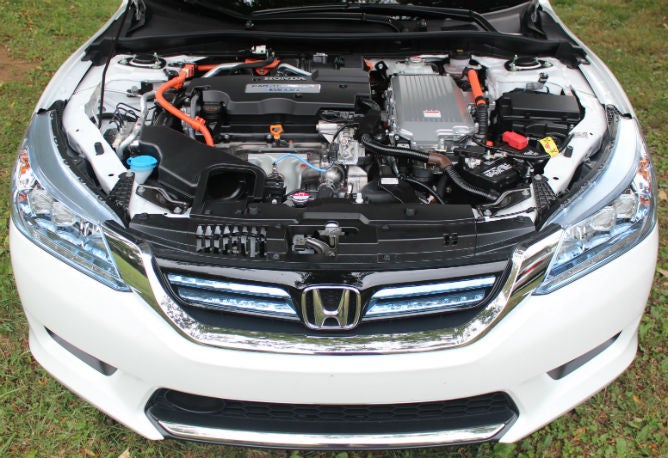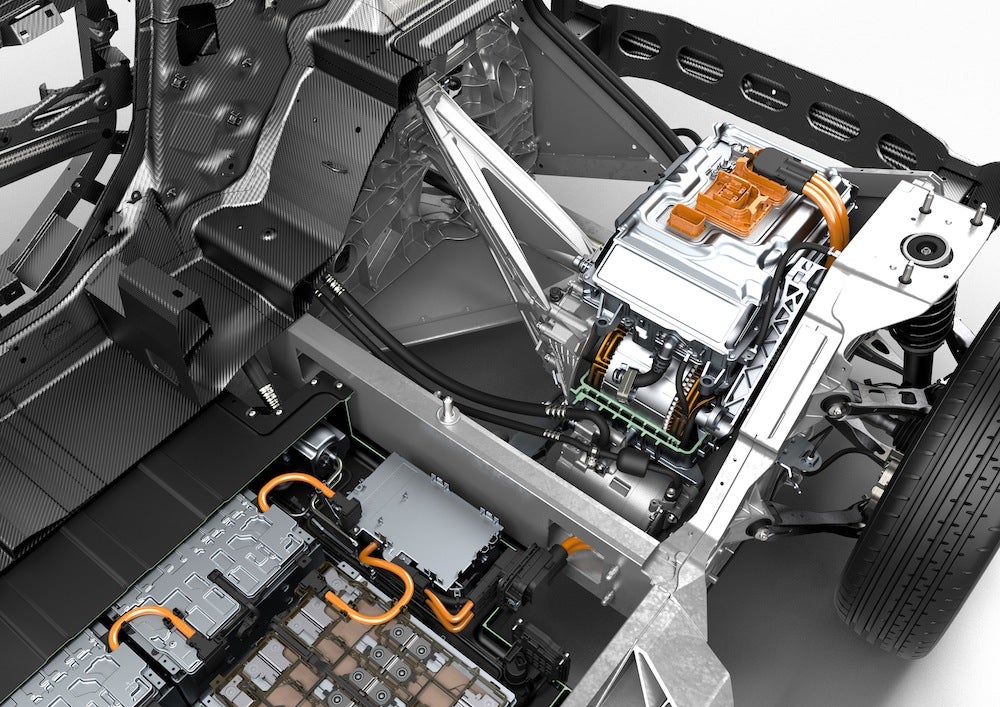 "BaconSandwich is tasty." (baconsandwich)
"BaconSandwich is tasty." (baconsandwich)
05/18/2015 at 22:59 ē Filed to: None
 0
0
 22
22
 "BaconSandwich is tasty." (baconsandwich)
"BaconSandwich is tasty." (baconsandwich)
05/18/2015 at 22:59 ē Filed to: None |  0 0
|  22 22 |
This is something that has been on my mind lately, and Iím curious about it.

Right now, most hybrid vehicles have some manner of direct connection from the internal combustion engine (ICE) to the wheels. For the first-generation Prius, this takes the form of three different differentials that allow a sort of three way connection between the ICE, electric motor, and wheels.
!!! UNKNOWN CONTENT TYPE !!!
The 2016 Chevrolet Volt uses a slightly different system that allows the electric motors to modify the speed of a ring gear/planetary gear setup in a sort of CVT setup.
!!! UNKNOWN CONTENT TYPE !!!
The Honda Accord works a bit differently, with a pair of electric motors, but still offers a direct mechanical connection between the ICE and the wheels at certain speeds.
!!! UNKNOWN CONTENT TYPE !!!
Obviously, thereís some pretty clever minds at work here, and it shows. Some of the engineering is quite intriguing. This does make me wonder though - what are the reasons for not simply running a large generator off the ICE and using one or more separate electric motors to drive the wheels? Is it simply a matter of efficiency?
Iíd think that a hybrid vehicle that uses the ICE solely as a generator could have some interesting benefits - one being that it would allow some different packaging for components. Because the ICE doesnít need a direct connection to the wheels, it could be placed wherever (e.g.: in the middle of a vehicle). It could also reduce the total number of moving parts - no more CVT, no more planetary gears, etc.
 CB
> BaconSandwich is tasty.
CB
> BaconSandwich is tasty.
05/18/2015 at 23:01 |
|
So, basically the Volt when it runs on gas mode?
 MLGCarGuy
> BaconSandwich is tasty.
MLGCarGuy
> BaconSandwich is tasty.
05/18/2015 at 23:03 |
|
The BMW i3, if I understand what youíre saying, does what you ask. It uses electric motors to drive the wheels, and uses a small motorbike engine to charge up the battery when itís low to add range. Essentially itís a power generator for the battery. It doesnít connect to the drive wheels, and itís mounted in the trunk.
 SidewaysOnDirt still misses Bowie
> CB
SidewaysOnDirt still misses Bowie
> CB
05/18/2015 at 23:05 |
|
Or the Fisker Karma which has probably devalued to pennies and looks amazing.
 BaconSandwich is tasty.
> MLGCarGuy
BaconSandwich is tasty.
> MLGCarGuy
05/18/2015 at 23:06 |
|
Yes! I had forgotten that the i3 works like this! I quite like the idea, but Iím wondering why other manufacturers donít seem to be going that route.
 BaconSandwich is tasty.
> CB
BaconSandwich is tasty.
> CB
05/18/2015 at 23:08 |
|
No. My understanding is that at certain speeds, the Volt still allows a direct mechanical connection between the motor and wheels:
http://www.technologyreview.com/view/427688/teÖ
EDIT: Better source:
http://www.plugincars.com/truth-out-abovÖ
 MLGCarGuy
> BaconSandwich is tasty.
MLGCarGuy
> BaconSandwich is tasty.
05/18/2015 at 23:09 |
|
Well right now the i3 has issues climbing hills with the range extender. Since the engine only turns on when the battery is at 5% and runs to keep it at 5%, the i3 is in a state of reduced power with the range extender on, and so you donít get max power when you need it. Pushing the accelerator when going up hills wonít do much; itíll actually slow down due to so little power.
 If only EssExTee could be so grossly incandescent
> BaconSandwich is tasty.
If only EssExTee could be so grossly incandescent
> BaconSandwich is tasty.
05/18/2015 at 23:10 |
|
There are two basic types of hybrids: Thereís Parallel, where the motor is connected to drive wheels and then the other axle has electric motors that join in/ take over as needed. Most hybrid versions of regular cars are set up like this. The other kind of hybrid is a Series hybrid, where the drivetrain is all-electric. There is no connections from the ICE to the wheels, it exists solely to charge the batteries. Most dedicated (meaning designed from the outset to be so) hybrids are Series. There are of course, exceptions and variations to these but most hybrids fall into one category or the other.
Series hybrids are typically more efficient but the drivetrain is more expensive to develop/ design.
 HammerheadFistpunch
> BaconSandwich is tasty.
HammerheadFistpunch
> BaconSandwich is tasty.
05/18/2015 at 23:15 |
|
I think at highway speeds, its slightly more efficient to put the power strait down...or at least thats what I recall from the last time I heard about it with the volt.
 BaconSandwich is tasty.
> MLGCarGuy
BaconSandwich is tasty.
> MLGCarGuy
05/19/2015 at 00:03 |
|
Interesting. The range extender in the i3 is pretty small, though, isnít it? Without having figures handy, I thought it was <1 litre. With something a little bigger, say a 1.0 L turbo, it opens some possibilities. It could run simply as a generator when the battery is low, it could run at various RPMs to provide power as needed while keeping the batteries topped up, or it could run at the curren load +10% to provide power for propulsion and charge the batteries at the same time.
 BaconSandwich is tasty.
> HammerheadFistpunch
BaconSandwich is tasty.
> HammerheadFistpunch
05/19/2015 at 00:05 |
|
Thatís what Iíve heard as well. Itíd be interesting to see some specific numbers. Is it 5% less efficient? 10%? 25%?
 MLGCarGuy
> BaconSandwich is tasty.
MLGCarGuy
> BaconSandwich is tasty.
05/19/2015 at 00:07 |
|
Itís a 650cc engine. But I agree that with a larger engine the i3 wouldnít have power issues. I have heard though that the engine might need some sound deadening, apparently it sounds like a sewing machine when on.
 BaconSandwich is tasty.
> MLGCarGuy
BaconSandwich is tasty.
> MLGCarGuy
05/19/2015 at 00:09 |
|
I might not doubt that! The new GM small gasoline engine is supposed to be a bit quieter than its competition. It might be well suited to a task like this.
 MLGCarGuy
> BaconSandwich is tasty.
MLGCarGuy
> BaconSandwich is tasty.
05/19/2015 at 00:10 |
|
It would. But the Volt has a whole engine bay dedicated to the engine. The i3 has to make do with a small rectangular space.

The generator is next to the wheel.
 Bill"TheStig"Murray
> BaconSandwich is tasty.
Bill"TheStig"Murray
> BaconSandwich is tasty.
05/19/2015 at 00:36 |
|
Bigger question, whatís with the lack of diesel hybrids?
 Cť hť sin
> Bill"TheStig"Murray
Cť hť sin
> Bill"TheStig"Murray
05/19/2015 at 04:58 |
|
There is a shortage rather than a lack. Mercedes and Peugeot do them and Iíve been in hybrid diesel buses.
Basically however theyíre too expensive ever to be common.
 Cť hť sin
> MLGCarGuy
Cť hť sin
> MLGCarGuy
05/19/2015 at 05:00 |
|
Thatís in America though. Elsewhere the engine starts at 25% charge and you can choose to start it manually from 75% charge downwards so if you know youíre going to be climbing a long steep hill you can retain some battery in reserve.
 Cť hť sin
> MLGCarGuy
Cť hť sin
> MLGCarGuy
05/19/2015 at 05:02 |
|
But the car is designed to comply with incentives somewhere which restrict range extender vehicles to no more than the electric range and performance when the engine is running. Thatís why the i3 has such a tiny tank.
 Cť hť sin
> BaconSandwich is tasty.
Cť hť sin
> BaconSandwich is tasty.
05/19/2015 at 05:04 |
|
ďwhat are the reasons for not simply running a large generator off the ICE and using one or more separate electric motors to drive the wheels? Is it simply a matter of efficiency?Ē
Yes, is the short answer. You have power losses in the generator, controller and motor and they all add up to more than the losses in a mechanical transmission.
 Distraxi's idea of perfection is a Jagroen
> BaconSandwich is tasty.
Distraxi's idea of perfection is a Jagroen
> BaconSandwich is tasty.
05/19/2015 at 05:11 |
|
I donít know the exact numbers, but I design electric motors for a living, so as an educated guesstimate:
Mechanical drive:
Regular gearbox efficiency: 90%
=Total efficiency 90%
Electric drive losses:
Generator efficiency 95%
Inverter efficiency: 95%
Electric motor efficiency: 90% (peak will be more like 95% but unless you have a CVT you wonít be running at peak very often)
Reduction gearset efficiency: 95%
=Total efficiency (0.95*0.95*0.9*0.95=) 77%
...so you pay a 13% penalty in the drivetrain through all those extra power conversions (+/-5% for my BS numbers, but I bet itís in the low-mid teens). So you only want to decouple the engine from the wheels when doing so would let you run the engine in a more efficient mode. Most gas engines have best efficiency from around 1/2-2/3 load and 1/2-2/3 speed, so anywhere close to that (e.g. steady state freeway running) decoupling the engine isnít going to be a win.
Youíd only design a fully decoupled hybrid where either packaging advantages dominated or where letting you always run the engine at constant revs/load allowed you to optimise hell out of it and get efficiency gains that overcome that 13%-ish loss.
 BaconSandwich is tasty.
> Bill"TheStig"Murray
BaconSandwich is tasty.
> Bill"TheStig"Murray
05/19/2015 at 08:34 |
|
A very good question indeed! I might suspect a slightly higher cost over existing hybrid prices, which consumers wouldnít like.
 bob and john
> BaconSandwich is tasty.
bob and john
> BaconSandwich is tasty.
05/19/2015 at 22:13 |
|
I thought the volt did what your talking about initially.
but I think the i3 does this
 BaconSandwich is tasty.
> bob and john
BaconSandwich is tasty.
> bob and john
05/19/2015 at 22:27 |
|
Yeah, the Volt is a bit different. At higher highway speeds it enables a direct connection. As far as I know (and have been reminded of in the other comments), the i3 seems to be the only one that does this. Unfortunately it is strapped with such a tiny engine, it canít do much more than run the car at a reduced speed if the battery is already depleted.